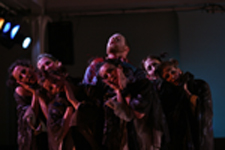
Jack Anderson
Saints and Sex
 |
|
"Saints and Sex"-Dancers: Aaron Mattocks, Jennifer Lafferty, Laura Arrington, Renee Archibald, Rebecca Serrell, Omagbitse Omagbemi, Derry Swan, and Darla Villani. Photo by Paula Court |
Christopher Williams
May 18-21, 2006
Danspace Project, St. Mark's Church, Second Avenue and Tenth Street, East
Village
Information: (212) 674-8112
Reviewed by Jack Anderson May 23, 2006
Religion and sex often find themselves locked together, sometimes in rapture, sometimes in torment. Christopher Williams vividly choreographed both conditions.
Religion came first: depictions of five saints excerpted from "Ursula and the 11,000 Virgins," staged last year, and "The Golden Legend," a work in progress. Each scene was named after a saint and was accompanied by musicians singing and playing Medieval compositions and original music by Peter Kirn.
I'm not a hagiographer, yet I found Williams's saints fascinating. "Saint Christopher" was a lumbering giant construction that came apart to reveal two dancers (Chris Elam and Williams) looking like lost lambs. "Saint Barbara" (Nami Yamamoto) hobbled grotesquely. The choreography made "Saint James the Greater" (Aaron Mattocks) gallop and stride in a sturdy, but endearingly awkward, manner, and a small ensemble hopped like toads, then undulated like the waves that carried this saint on his voyages. While another small group prowled, growled, and made spitting noises, "Saint Lucy" (Janet Charleston) tried to stand tall and maintain her dignity, yet also trembled and moaned, as if enduring torture. Finally, "Saint Anthony Abbott" (John Kelly) resisted temptations personified by puppeteers holding puppets resembling little devils. Williams's dances were as fantastic as gargoyles, and Carol Mullins's lighting added to their mystery.
After religion came sex, gay sex. But this was sex in an environment in which religious tradition pronounced sex in general sinful and gay sex anathema. Williams's new "Portuguese Suite" was set to fados (Portuguese songs of love and death) as recorded by Amália Rodrigues (1920-1999), a celebrated exponent of the form. The melancholy melodies perfectly suited this choreographic lament about the love between an American Sailor (Williams) and a Portuguese Sailor (Andrei Garzón) who tumbled about the stage as if caught in ocean waves and tides of passion. Black-clad mourning women emerged from cross-topped cubicles, designed by John Bianchi, that resembled both sentry boxes and confessionals, and they throbbed in sympathy with a character the program called the Betrothed (Jennifer Lafferty). These women possibly symbolized both the heterosexual love the men had abandoned and the judgment of society upon transgressors.
Finger pointing became a recurrent gestural motif, and the fingers, in red gloves which made them impossible to miss, could be pointing to call attention to the self and to express either desire or condemnation. Dancing together, the men lifted each other and kissed, while the mourners scattered across the stage. The men also grappled with mixed emotions, as when the Portuguese Sailor tentatively approached the women, only to return to the American, looking simultaneously loving and bewildered. More passionate embraces followed. But they didn't last, for the Portuguese Sailor finally ran off.
A sort of nautical "Brokeback Mountain" with its
own guilt-ridden unhappy ending, "Portuguese Suite" was often
flamboyant, yet avoided melodramatic excess. Williams has created a choreographic
fado.
| museums | NYTW mail | recordings | coupons | publications | classified |
